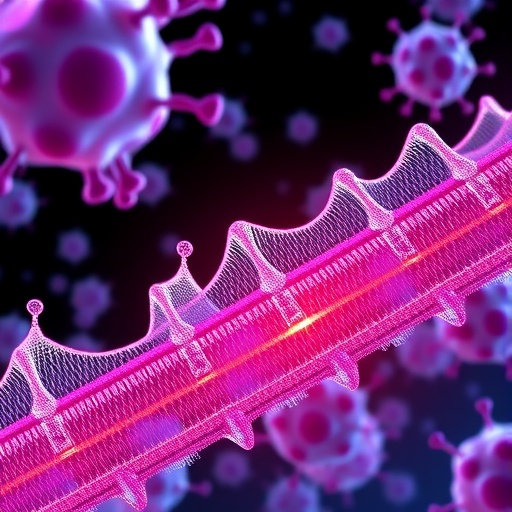Scientists derive a new compound from eushearilide, which can potentially take on lethal fungal and bacterial infections

Credit: Tokyo University Of Science
Immunodeficiency is the condition where the capability of the immune system to fight against diseases has been compromised. Immunocompromised people have a higher chance of contacting diseases compared to people with healthy immune systems. Immunodeficiency usually occurs as a consequence of several factors, such as diseases like AIDS and diabetes, chemotherapy, and organ transplant. Recently, doctors have noted an increased trend in the occurrence of life-threatening fungal infections–also called mycoses–in immunocompromised patients. In such cases, treatment requires the use of some special compounds with antifungal properties. Unfortunately, antifungal drugs currently available are very limited.
In 2006, a lead compound “eushearilide,” derived from fungi, was discovered. It was found to have antifungal and antiyeast properties, and could tackle several fungi that were known to cause infections in humans. A team of scientists from the Tokyo University of Science had previously explored the unique chemical structure and the method of synthesis of eushearilide. Now, this research group, led by Prof. Isamu Shiina of the Tokyo University of Science–which also includes Takayuki Tonoi (Tokyo University of Science), Katsuhiko Kamei (Medical Mycology Research Center, Chiba University) and Naruhiko Ishiwada (Medical Mycology Research Center, Chiba University)–has used their previous findings to derive compounds from eushearilide that may have improved beneficial effects. This study is published in the journal Molecules. Their aim, Prof. Shiina explains, was “to look at the antibacterial effects on various fungi and bacteria of the new antibacterial lead compound 23-demethyleushearilide, colloquially called ‘usharelide,’ derived from eushearilide.”
For this, first, usharelide had to be derived from eushearilide. This was achieved through a set of reactions involving the alteration of molecules attached at the 23rd carbon atom of eushearilide. Once usharelide and its structural variations were derived, they were tested for their antibiotic properties, specifically against fungi and bacteria. The researchers found that these compounds had significant promising antibiotic properties. In particular, two of the several variations of usharelide showed antimicrobial properties against Candida albicans, a fungus that is the instigator of yeast infections. Meanwhile, most of the variations showed antimicrobial properties against Cryptococcus neoformans, which causes lung infections, meningitis, and encephalitis, particularly in AIDS patients. This finding echoed the previous findings on the antifungal properties of eushearilide. However, what was even more interesting is that these usharelide variations also showed good antibacterial properties against several disease-causing bacterial species, including methicillin-resistant Staphylococcus aureus (MRSA), which is known to be a particularly difficult bacterium to tackle due to its resistance to several antibiotics and causes potentially fatal infections, particularly in people with weak immune systems.
These findings emphasize the unique status and importance of eushearilide and its derivative usharelide in the treatment of several fungal diseases in immunocompromised people. More significantly, these findings also shed light on the possible antibacterial properties of these compounds, which have not been adequately explored in research before. Usharelide has the potential for application in the treatment for patients with fungal diseases such as candidiasis, and in the elimination of hospital-origin infections caused by MRSA and vancomycin-resistant enterococci. Prof. Shiina stresses on the importance of further studies, stating, “Antibiotic properties of eushearilide derivatives are not only against various fungi but also against bacteria, especially important drug-resistant bacteria such as MRSA. This is a novel finding that definitely warrants deeper research, given the urgent need for MRSA treatment options.”
This study definitely promises to be a step in the right direction for treating recalcitrant infections in immunocompromised people caused by dangerously pathogenic bacteria, which were once thought to be unconquerable.
###
About The Tokyo University of Science
Tokyo University of Science (TUS) is a well-known and respected university, and the largest science-specialized private research university in Japan, with four campuses in central Tokyo and its suburbs and in Hokkaido. Established in 1881, the university has continually contributed to Japan’s development in science through inculcating the love for science in researchers, technicians, and educators.
With a mission of “Creating science and technology for the harmonious development of nature, human beings, and society”, TUS has undertaken a wide range of research from basic to applied science. TUS has embraced a multidisciplinary approach to research and undertaken intensive study in some of today’s most vital fields. TUS is a meritocracy where the best in science is recognized and nurtured. It is the only private university in Japan that has produced a Nobel Prize winner and the only private university in Asia to produce Nobel Prize winners within the natural sciences field.
Website: https:/
About Professor Shiina from Tokyo University of Science
Isamu Shiina is a professor of chemistry at Tokyo University of Science, Japan. He completed his PhD from the University of Tokyo. He has received several awards, including the Chemical Society of Japan (CSJ) Award for Young Chemists (1997), the CSJ Award for Creative Work (2013), and the Commendation for Science and Technology Prizes by the Ministries of Japan (2015). His research areas on interest include the development of useful synthetic methods and the total synthesis of natural products.
Media contact
Tsutomu Shimizu
Email: [email protected]
Media Contact
Tsutomu Shimizu
[email protected]
Related Journal Article
http://dx.





